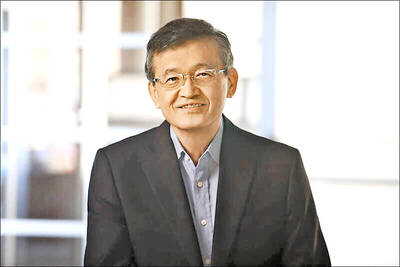Tesla Inc on Tuesday reported a hefty drop in second-quarter profits due to the effect of price cuts while spending aggressively on autonomous driving and other technology.
Elon Musk’s electric vehicle (EV) company reported profits of US$1.5 billion, down 45 percent, on revenues of US$25.5 billion, which were up two percent behind an increase in its energy generation and storage business.
Tesla’s earnings per share missed analyst expectations, while revenues exceeded them.

Photo: Eduardo Munoz, Reuters
The results are the latest in a rough patch for Musk’s EV titan as it contends with rising competitive pressures that prompted a string of price cuts across leading markets.
Tesla laid off 10 percent of its global staff this year — about 14,000 workers — as part of a push to cull expenses to finance major new investments.
That reorganization also resulted in one-time expenses of US$622 million in the second quarter due to severance and other costs, chief financial officer Vaibhav Taneja said.
While vehicle sales fell compared to the year-ago period, they rose from the level in the first quarter as “overall consumer sentiment improved,” Tesla said in its earnings presentation.
Although Tesla reaffirmed its expectation that vehicle volume growth may be “notably lower” than last year’s, it said new, more affordable models are set to begin production in the first half of next year.
Musk announced the accelerated timeframe in April, winning cheers from Wall Street which had sought fresh offerings.
However, he declined on Tuesday to offer new details, saying the topic would be covered in a product launch event.
Tesla said its iconoclastic Cybertruck vehicle remains on track for profitability by the end of this year as it ramps up production.
Tesla vowed to press on with technological pushes in artificial intelligence (AI) and autonomous driving.
The company postponed this month a much-anticipated robotaxi event planned for next month until October.
Musk told a conference call that “moving it back a few months allowed us to improve the robotaxi as well as add in a couple other things for the product unveil” now set for Oct. 10.
The outspoken Musk has a history of making bold predictions about the prospects for autonomous vehicles. But he has fallen short of projections about the timeframe for self-driving technology, after previously predicting the company would achieve the breakthrough by 2018.
Musk acknowledged his “overly optimistic” prior forecasts but said he expects the robotaxi could achieve full autonomy by the end of this year, adding “I would be shocked if we cannot do it next year.”
The results come as Musk has lately deepened his commitment to electoral politics, coming out loudly for Donald Trump in this year’s presidential election despite the former president’s longstanding denial of climate change — which has been a professed Musk priority.
Musk formally endorsed Trump on July 13 shortly after a shock assassination attempt on the Republican presidential nominee.
Musk has agreed to donate US$45 million monthly to America PAC, a fund focused on electing Trump, starting this month, the Wall Street Journal reported this month.
But the Tesla chief acknowledged that a Trump victory might affect a plan announced in March last year to build a new Gigafactory in Mexico, given that the Republican candidate has vowed “heavy” tariffs on Mexican goods.
“I think we need to see just where things stand after the election,” Musk said.

Intel Corp chief executive officer Lip-Bu Tan (陳立武) is expected to meet with Taiwanese suppliers next month in conjunction with the opening of the Computex Taipei trade show, supply chain sources said on Monday. The visit, the first for Tan to Taiwan since assuming his new post last month, would be aimed at enhancing Intel’s ties with suppliers in Taiwan as he attempts to help turn around the struggling US chipmaker, the sources said. Tan is to hold a banquet to celebrate Intel’s 40-year presence in Taiwan before Computex opens on May 20 and invite dozens of Taiwanese suppliers to exchange views

Application-specific integrated circuit designer Faraday Technology Corp (智原) yesterday said that although revenue this quarter would decline 30 percent from last quarter, it retained its full-year forecast of revenue growth of 100 percent. The company attributed the quarterly drop to a slowdown in customers’ production of chips using Faraday’s advanced packaging technology. The company is still confident about its revenue growth this year, given its strong “design-win” — or the projects it won to help customers design their chips, Faraday president Steve Wang (王國雍) told an online earnings conference. “The design-win this year is better than we expected. We believe we will win

Chizuko Kimura has become the first female sushi chef in the world to win a Michelin star, fulfilling a promise she made to her dying husband to continue his legacy. The 54-year-old Japanese chef regained the Michelin star her late husband, Shunei Kimura, won three years ago for their Sushi Shunei restaurant in Paris. For Shunei Kimura, the star was a dream come true. However, the joy was short-lived. He died from cancer just three months later in June 2022. He was 65. The following year, the restaurant in the heart of Montmartre lost its star rating. Chizuko Kimura insisted that the new star is still down

While China’s leaders use their economic and political might to fight US President Donald Trump’s trade war “to the end,” its army of social media soldiers are embarking on a more humorous campaign online. Trump’s tariff blitz has seen Washington and Beijing impose eye-watering duties on imports from the other, fanning a standoff between the economic superpowers that has sparked global recession fears and sent markets into a tailspin. Trump says his policy is a response to years of being “ripped off” by other countries and aims to bring manufacturing to the US, forcing companies to employ US workers. However, China’s online warriors